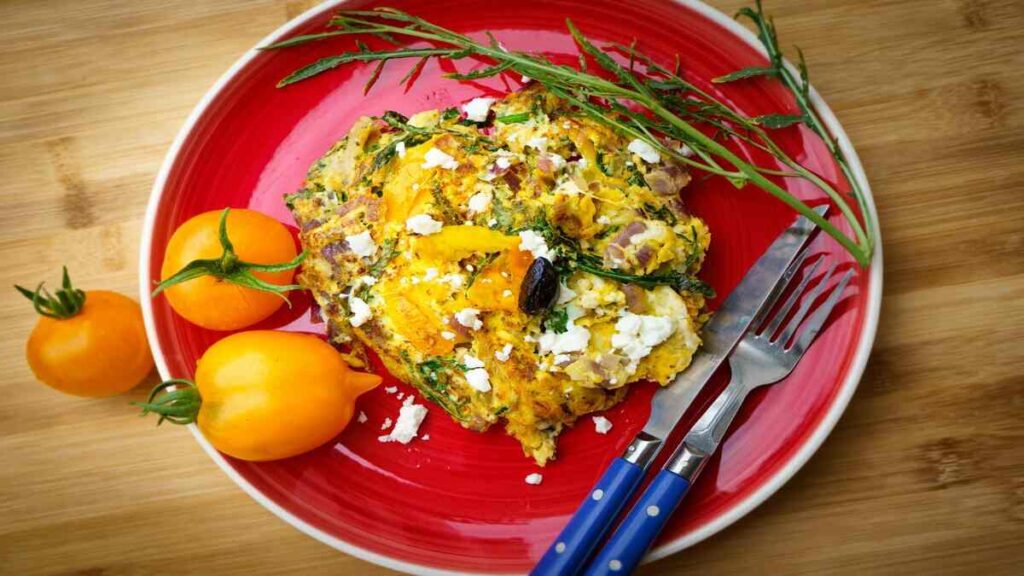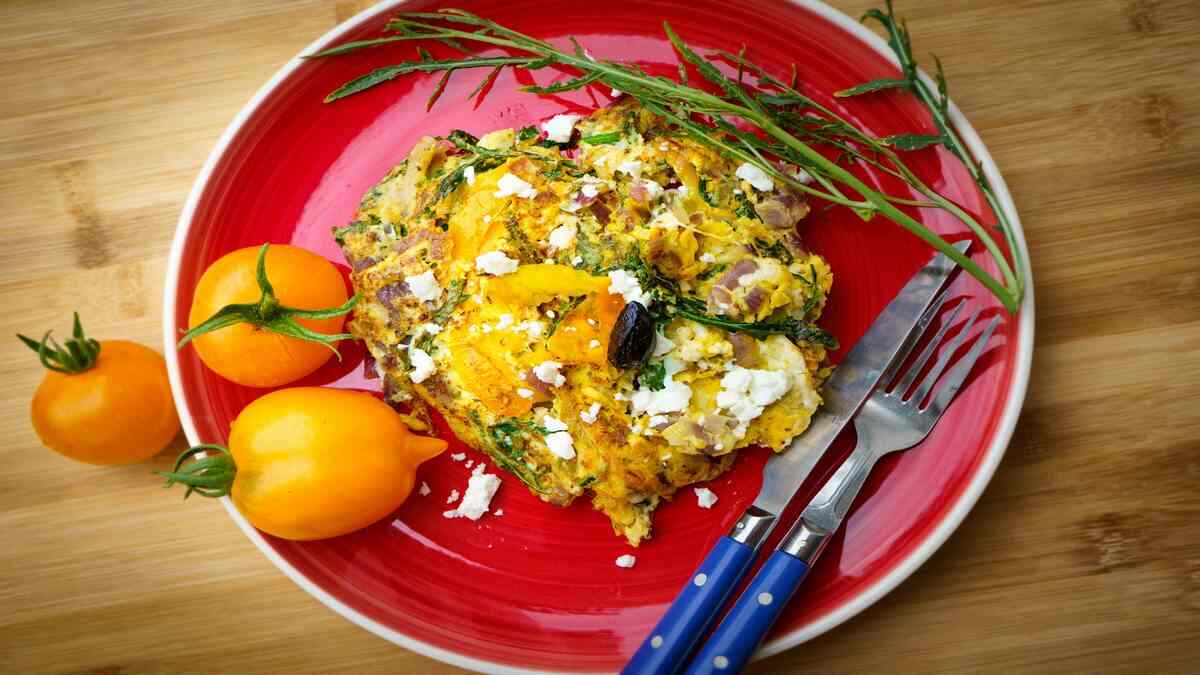A frittata is more than just an egg dish; it’s a culinary blank canvas that transforms simple ingredients into a masterpiece. Known for its ease of preparation, versatility, and ability to be served at any meal, the frittata has become a beloved choice for food enthusiasts worldwide. Whether you’re looking to clean out your fridge or impress guests with a hearty, delicious meal, a frittata Recipe is the answer.
In this article, we’ll dive into what a frittata is, its origins, ingredients, step-by-step preparation, health benefits, and more. Let’s crack some eggs and get started!

What Is a Frittata Recipe?
A frittata is an Italian egg-based dish similar to an omelette or crustless quiche. Unlike an omelette, which is folded, a frittata is cooked flat and finished in the oven or under a broiler. Packed with vegetables, cheese, meats, or even pasta, it’s a hearty dish that can be customized to suit any taste.
The beauty of a frittata lies in its simplicity—it’s as perfect for a casual breakfast as it is for a sophisticated brunch or dinner.
The Origin of Frittata Recipe
The word “frittata” comes from the Italian term fritto, meaning “fried.” Historically, the dish was a way to use up leftovers, combining eggs with any available ingredients. Over time, it became a distinct recipe, celebrated for its rustic charm and adaptability. Today, the frittata is a staple in Italian cuisine and a global favorite, thanks to its delicious flavors and ease of preparation.
Ingredients for Frittata Recipe
A classic frittata requires a few basic ingredients, but you can add almost anything to suit your preferences:
Basic Ingredients:
- Eggs: 6-8 large eggs.
- Milk or Cream: ¼ cup for a creamy texture.
- Cheese: ½ cup shredded (cheddar, mozzarella, feta, or parmesan).
- Vegetables: 1-2 cups of chopped vegetables (spinach, bell peppers, onions, mushrooms, zucchini, etc.).
- Protein: Optional cooked meats like bacon, sausage, ham, or chicken.
- Seasoning: Salt, pepper, and herbs (thyme, basil, parsley).
Optional Add-Ins:
- Cooked pasta or potatoes.
- Sun-dried tomatoes or olives for extra flavor.
Equipment You’ll Need
- A large oven-safe skillet (cast iron works best).
- Mixing bowl and whisk.
- Knife and cutting board for prepping ingredients.
- Measuring cups and spoons.
Step-by-Step Preparation
1. Prepare Your Ingredients
Start by preheating your oven to 375°F (190°C). Chop all vegetables and prepare any cooked meats or pasta you’d like to include. Whisk together the eggs, milk or cream, cheese, salt, and pepper in a bowl.
2. Cook the Fillings
Heat a tablespoon of olive oil or butter in your skillet over medium heat. Sauté the vegetables until tender, and add any cooked meats or seasonings. Spread the mixture evenly in the skillet.
3. Add the Eggs
Pour the egg mixture over the fillings, ensuring it covers the entire skillet. Stir gently to distribute ingredients evenly.
4. Cook on the Stove
Cook the frittata on the stove over low heat for about 5 minutes, allowing the edges to set while the center remains slightly runny.
5. Finish in the Oven
Transfer the skillet to the preheated oven and bake for 10-15 minutes, or until the center is firm and the top is golden brown.
6. Cool and Serve
Allow the frittata Recipe to cool for a few minutes before slicing. Serve warm or at room temperature.
Health Benefits of Frittata

Frittatas are not only delicious but also packed with nutrients:
- High in Protein: Eggs are a rich source of high-quality protein, supporting muscle growth and repair.
- Loaded with Vegetables: Adding vegetables boosts the fiber, vitamins, and antioxidants in your meal.
- Low-Carb Option: A frittata can be a great choice for low-carb or keto diets.
- Customizable Nutrition: You can adapt the ingredients to suit dietary needs, such as using plant-based proteins or dairy-free cheese.
Additional Tips for Perfect Frittata Recipe
- Use Fresh Ingredients: Fresh vegetables and high-quality eggs make a noticeable difference in flavor.
- Don’t Overcook: Overcooking can result in a dry frittata. Remove it from the oven as soon as it’s set.
- Experiment with Flavors: Try different combinations of cheese, herbs, and fillings to keep things exciting.
- Meal Prep: Frittatas can be made ahead of time and stored in the fridge for up to 3 days. They’re perfect for quick breakfasts or lunches.
Best Way to Serve Frittata Recipe
Frittatas can be served warm, cold, or at room temperature. Here are some serving suggestions:
- As Is: Enjoy a slice on its own as a complete meal.
- With a Side Salad: Pair with a fresh green salad for a balanced lunch or dinner.
- On Toast: Place a slice on crusty bread for a hearty breakfast.
- With Dips: Serve with sour cream, salsa, or hot sauce for added flavor.
Calories and Nutritional Information
The calorie count for a frittata varies based on the ingredients, but a standard slice (1/6 of an 8-egg frittata with cheese and vegetables) contains approximately:
- Calories: 200-250
- Protein: 12-15g
- Fat: 15g
- Carbohydrates: 4-6g
(Note: Values may differ depending on add-ins and portion sizes.)
Preparation Time and Cooking Time
- Preparation Time: 10-15 minutes
- Cook Time: 15-20 minutes
- Total Time: ~30-35 minutes
Conclusion
A frittata is the ultimate dish for anyone seeking a versatile, nutritious, and delicious meal. Its adaptability makes it a fantastic choice for any time of day, and its ease of preparation ensures success for cooks of all skill levels. Whether you stick to the classic recipe or get creative with your favorite ingredients, a frittata is a culinary delight that never disappoints. So grab your skillet and start whipping up this timeless dish today!
FAQs
1. Can I make a frittata without an oven?
Yes! You can cook the frittata entirely on the stovetop by covering the skillet with a lid and cooking on low heat until the center is set.
2. How do I store leftover frittata Recipe ?
Let the frittata cool completely, then store slices in an airtight container in the refrigerator for up to 3 days.
3. Can I freeze a frittata ?
Absolutely! Wrap individual slices tightly in plastic wrap and freeze for up to 2 months. Reheat in the oven or microwave before serving.
4. What’s the difference between a frittata and an omelette?
A frittata is thicker, cooked slowly, and finished in the oven, while an omelette is thinner, cooked quickly, and folded over the fillings.
5. Can I make a vegan frittata?
Yes! Use tofu or chickpea flour as an egg substitute and add your favorite plant-based ingredients for a delicious vegan version.
